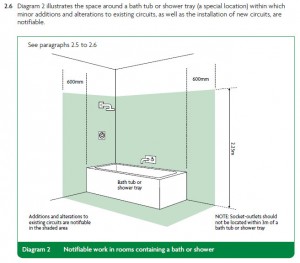Part P Electrical Safety
Part P Electrical Safety
In 2005, the Government introduced Approved Document P Electrical Safety into the building regulations (England and Wales). This regulation ensures all domestic electrical installations and alterations made to existing installations (except some types of minor work) are designed and installed to meet the standards set out in the building regulations. Therefore, by law, all homeowners and landlords must be able to prove that all electrical installation work meets the requirements set out in Part P, or they will be committing a criminal offence. Local authorities can instruct you to remove or alter electrical work that does not meet these requirements.
Part P stipulates that when some someone is planning to undertake electrical works they must either:
- Tell the local building control about the installation in advance so that the council’s building control officer can inspect the work, or
- Employ an electrician who is registered with one of the five government-approved competent self-certification schemes. The ‘competent person’ must provide a self-certification certificate to the customer and forward a copy to the Local Authority within 30 days.
Competent self-certification schemes.
There are two type of scheme. The first being Full Scope registrations. With this scheme an electrician can register with one of the following bodies; BRE Certification Ltd, British Standards Institution (BSI), ELECSA Ltd, NAPIT Certification Ltd, and NICEIC Certification Services Ltd. The second scheme is called the Defined Scope registration. The bodies which cover this scheme are CORGI, ELECSA, NAPIT, NIC or FTEC. This scheme enables associated trades to carry out a limited amount of electrical work in dwellings as part of their associated work activity. For example: installing new circuits from the consumer unit or adding additional points to existing circuits.
Changes to Part P
In April 2013, the Government made important changes to Part P of the Building Regulations. The two main changes were:
1. The extent of the work that must be checked by a building control body unless undertaken self-certified by an installer registered with a competent person scheme has been reduced.
2. There is now provision to allow the use of a registered third party to certify notifiable work.
From April 2013, electrical work in kitchens or external electrical work will no longer be notifiable apart from installing a new circuit.
Electrical installation work that is now notifiable includes:
A The installation of a new circuit
B) The replacement of a consumer unit or
C) Any addition or alteration to existing circuits in a special location
A special location means:
A) A room containing a bath or shower, the space surrounding a bath tap or shower head where the space extends
- vertically from the finished floor level to a height of 2.25M or the position of the shower head where it is attached to a wall or ceiling at a height higher than 2.25 metres from that level and
- horizontally where there is a bath tub or shower tray, from the edge of the bath tub or shower tray to a distance of 0.6 metres. Or where there is no bath tub or shower tray from the centre point of the shower head where it is attached to the wall or ceiling to a distance of 1.2 metres.
(Reference: Diagram from Part P Approved Document, 2013)
The requirements of Part P also apply to a room containing a swimming pool or sauna heater.
Non- notifiable work
All other electrical installation work is not notifiable – namely additions and alterations to existing installations outside special locations, and replacements, repairs and maintenance anywhere.
Installing fixed electrical equipment is within the scope of Part P, even if the final connection is by a standard 13A plug and socket, but is notifiable if it involves the installation of a new circuit, the replacement of a consumer unit or work in a special location as described above.
Certification by a registered third party
The second major change relates to the use of a registered third party to certify notifiable work.
Before April 2013, electrical works covered by Part P undertaken by a person not registered with a competent persons’ scheme could only be deemed compliant by local authority building control.
Under the new Part P, the third party certification schemes allows electrical works undertaken by those who are not registered with a competent persons scheme to get the work inspected and tested by a registered third party to confirm that it complies with the building regulations.
Within 5 days of completing the work, the installer must notify the registered third-party certifier who, subject to the results of the inspection and testing being satisfactory, should then, within 30 days, complete an electrical installation condition report and give a copy of the building regulations compliance certificate to the occupier and give the certificate or a copy of the information on the certificate, to the building control body.
It could be considered that the new Part P is really a dumbing-down of standards resulting in incompetent electrician and diyers producing substandard or potentially dangerous work, putting lives at risk.

